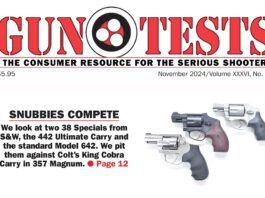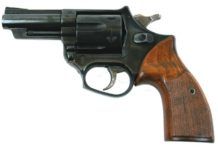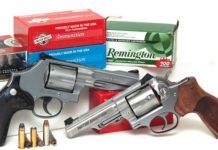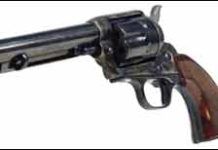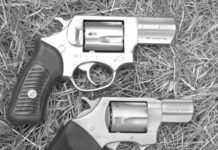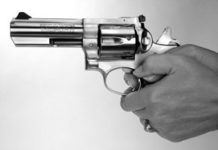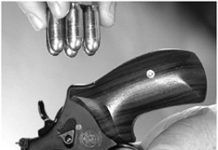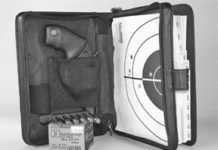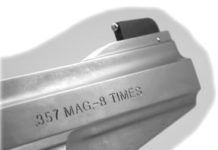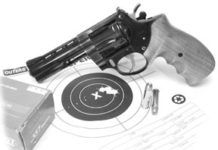High-Capacity 357 Magnum Carry Revolvers from S&W
Like so many other shooters, our evaluators like the 357 Magnum cartridge for defense as well as the flexibility of lower-recoil and lower-cost training using 38 Special ammunition. To see if we could find a bargain, we wanted to pit two expensive high-capacity snubnose revolvers in that chambering—the Models 327 and 627—and add into the mix a more traditional, affordable used six-shot snubnose, the Model 686 164231, which is no longer in current production but which is widely available from around $600 to $800.
The 6-shot Model 686 is the stainless-steel version of the Model 586, which debuted in 1981 and was one of the first L-frame or medium-sized revolvers offered by S&W. The L-frame guns are slimmer and lighter than the hefty N-frames. Both the Model 586 and the Model 686 were immensely popular with law enforcement, outdoorsmen, competition shooters, and home defenders. The 586 went out of production but was reintroduced a few years ago. The Model 686 is a pure S&W classic that is able to withstand continued use of 357 Magnum ammo. We have reviewed the 686 in various configurations in past issues, such as the 2.5- (No. 164192, Grade A January 2002), 4- (No. 164194, Grade A March 2007), 6- (No. 164224, Grade A- March 2011), and 8.4-inch (Grade A February 2001) barrels and the Plus variant (M686-6, Grade A January 2002), which has a 7-shot capacity, and all have been excellent revolvers. We have also reviewed the Model 327 in the past (Grade B February 2005). The snubnose revolver new to our team is the Performance Center Model 627.
Smith & Wesson introduced the first, the original, 357 Magnum revolver in 1935 known as the Registered Magnum. S&W chose to chamber the powerful 357 Magnum cartridge in a six-shot revolver built from the company's large, heavy-duty carbon-steel N-frame. Almost immediately, the Registered Magnum was adopted by the Kansas City Police Department, and other LE agencies soon followed. To say the revolver and cartridge combination was successful is an understatement. When introduced at the height of the Great Depression, the revolver cost $60 — nearly a king's ransom in those days. Yet Smith & Wesson had a hard time filling these special-order items because the big N-frame had a lot of desirable details, such as a pinned barrel, counterbored cylinder chambers, and checkering across the top strap of the frame and barrel.
Over the years, the revolver went through several name changes. In the late 1930s, the model name was changed to ".357 Magnum." Eventually, it would become known as the Model 27 when S&W started to use numeric model names in the mid-1950s.
General George S. Patton carried a 357 Magnum model and outfitted it with ivory grips and a Tyler T-grip to fill that gap between the rear of the trigger guard and front strap. He called it his "killing gun." From the 1940s through the 1960s, many FBI agents used a 3.5-inch-barrel model. J. Edgar Hoover is said to have owned one of the first Registered Magnums. Noted gun writer Skeeter Skelton was known to favor a 5-inch-barrel model. In 1994, the M27 was dropped by S&W, and wheelgun aficionados gasped with despair. Around 2009, the Model 27 was reintroduced.
In that gap when Model 27 production went dark, S&W brought out the Model 627 in 1996. Following a similar introduction as the Registered Magnum, the Model 627 is a semi-custom gun produced by S&W's Performance Center. S&W enhanced the Model 627, making it an 8-shot 357 Magnum. In 2008, another 8-shot N-frame debuted, the Model 327. These two models are direct descendants of the Registered Magnum, and these newer-generation guns offer added capacity and are constructed of different materials.
To find out how they were all put together, first we used Brownell's revolver range rod for 38/357 Service (080-617-038WB, $40) on the used 686 to check the alignment of the six chambers and the barrel. The rod slid down the barrel and into each chamber, so we were confident that the 686, though used, would still perform. We also checked the new 627 and 327, and all their chambers checked out. We used a Go/No Go 60/68 Cylinder Gauge (080-633-668WB, $36) from Brownells to check the headspace on the revolvers, which is the gap between the rear of the cylinder and recoil plate in frame. The used 686 was in spec. If the gap is too big, the revolver may misfire. The new revolvers were in spec, too. All revolvers exhibited a tight lock up of cylinder to frame. The full-size, old-style cylinder latch was loose on the 686, but a flat-blade screwdriver took care of that issue.
Are Used 357 Mags from Colt, S&W, and FN Worth the Money?
The 357 Magnum has an excellent reputation as a defensive round. On medium-sized game like whitetail deer at modest distances, it is effective as well. The round has been around since 1934; General George Patton carried an ivory-handled S&W 357 Mag during WWII. It is a versatile cartridge with many bullet types offered by a variety of manufacturers. Plus, 38 Special ammo in standard and +P loadings can be used in a 357 Magnum as a low-recoil alternative when training or plinking. We wanted to see if we could find a bargain in a full-size revolver with a 4-inch barrel that we could use for personal protection, and we came across two such contenders, a Smith & Wesson Model 19-4 that rated about 90 to 95 percent and a Colt Trooper MK III that rated 80 to 90 percent. Both featured 4-inch barrels, adjustable sights, and wood grips. We also came across an uncommon choice in this chambering, an FN Barracuda, available in the 1970s on a limited basis. It is unique due to the availability of an interchangeable cylinder, which could be switched between 9mm Luger and 357 Magnum. Here's more about these interesting and affordable choices, along with our recommendations.
IDPA Revolvers: Rugers Match Champion, S&Ws Pro 686 SSR
If you believe the revolver is obsolete, think again. The double-action revolver is now more relevant than ever. Haven't you noticed the trend toward hinged triggers working the action of semi-automatic pistols? Based on developing trigger control, a double-action revolver may now be a more appropriate training device than the typical single-action-only rimfire pistols so often used to introduce beginners to shooting a handgun. The vast majority of double-action revolvers can also be fired single action simply by thumbing back the hammer. This accommodates the arthritic or partially disabled. In addition, you can utilize the same revolver to develop trigger control for single action as well as double action only and double action/single action handguns. Revolvers employ fixed barrels, making them inherently more accurate than semi-automatic pistols wherein the barrel and slide (including the sights) move in and out of position with every shot.
You can leave a revolver loaded for the life of the ammunition and, unlike a magazine-fed pistol, its ability to cycle rounds will not be affected by magazine-spring fatigue. Nor will the outline or shape of the bullets interfere with chambering. You can safely load frangible rounds, such as rat shot or snake-shot, without malfunction and even load a mix of both high-velocity and low-velocity ammunition, again without malfunction.
But our motivation for testing the Ruger GP100 Match Champion and Smith & Wesson Pro Series 686 SSR 357 Magnum revolvers is more exciting than any of the arguments above. These guns were designed to compete in the Stock Service Revolver division of International Defensive Pistol Association or, IDPA. Both revolvers meet the physical requirements to be eligible for SSR competition — a maximum barrel length of 4.2 inches or less and a maximum unloaded weight of 43 ounces or less. Stock Service Revolvers may have the capability to chamber additional rounds, but in competition, no more than six rounds may be loaded at any time.
Whereas these guns are recognized as 357 Magnum revolvers, their versatility allows them to fire 38 Special ammunition as well. And IDPA rules allow for the shooter to choose either caliber for competition. For our tests, we chose two rounds of 38 Special and one variety of 357 Magnum. Our 38 Special rounds were Remington 125-grain +P semi-jacketed hollowpoints and Black Hills 148-grain hollow-based wadcutter rounds. The Remingtons are an intermediate-power defense load, and the lead wadcutters are a popular target load commonly used in competitions that demand accuracy, such as NRA Action Pistol, PPC, and Bullseye. Our choice of magnum rounds was Federal 130-grain Hydra-Shok Personal Defense Low Recoil hollowpoint ammunition. To assess accuracy, we fired a series of five-shot groups single action only from a sandbag rest. Test distance was 25 yards. To determine average velocity, we fired shots from all six chambers across an Oehler Research Model 35P printing chronograph.
Cowboy Revolvers: Cimarron Outduels Ruger, Heritage 357s
In Cowboy Action Shooting, the targets are usually not especially hard to hit, but the action is very quick, which means a smooth, slick, easy-to-handle revolver gives the shooter an edge. Many shooters will want to get into the game with an "original" — a real Colt, but those sixguns are very expensive and pretty scarce, and those guns are not without their own special problems. But there are plenty of more recent choices in single-action revolvers, and we've tested quite a few. In the February 2006 issue, we called the Heritage Manufacturing Big Bore Rough Rider 45 Colt RR45B5, $379, a Best Buy when tested against a Taurus Gaucho SA45B 45 Colt, $499, which was a Don't Buy model. In March 2005, we shot three more handguns chambered in 45 LC, the Ruger New Vaquero NV-455 No. 5101, $583; Beretta's Stampede JEA1501, $540; and a retest of Cabela's Millennium revolver, $280, with brass frame. We said the Millennium was a Best Buy, followed by the Stampede with a Buy It recommendation, and a Conditional Buy grade for the New Vaquero, which skipped two of the cylinders. In July 2003, we tested four more 45 Colt single actions, saying "Buy It" for the American Western Arms Peacekeeper, $835, and the Uberti Regulator, about $400. A Colt Single Action Army, about $1,700, got a Conditional Buy recommendation for its cost and troublesome operation. Our Pick of the test was a USFA Mfg. Co. Rodeo, about $500. More 45 Colts were tested in April 2001, with Cabela's Millennium Revolver, $200, earning a Best Buy nod over a 1907 Colt SAA, about $1,500; and Ruger's Bisley Vaquero, $450 (both Conditional Buys).
Many of these guns were interesting because they're chambered in the more traditional 45 Long Colt, originally released in the blackpowder cartridge era of 1873-1890. Today, however, low-recoil loads help you go faster in SASS, and if your revolvers shoot 357 Magnums, you can buy a lever gun in the same caliber and shoot the same low-powder loads without having to worry about inserting the wrong shell. Way back in May 2000, we did test three "cowboy concealable" revolvers chambered for 357 Magnum, the EMF Hartford Sheriff's Model ($365, Don't Buy); the Cimarron New Sheriff ($469, Don't Buy), and the Cimarron Thunderer ($489, Conditional Buy). It was far past time to update the smaller-bore single-action revolvers suitable for CAS, so we chose two reproduction Colts and Ruger's New Vaquero, all chambered in the most common CAS competition caliber, 357 Magnum. Our choices were the Ruger New Vaquero NV-34 No. 5107, $719; the Heritage Manufacturing Big Bore Rough Rider RR357CH4, $500; and Cimarron's Evil Roy No. ER4104, $770.
The Heritage and the Cimarron revolvers stayed true to the look of the Colt, with case-hardened frames and wood grips. The Ruger had a few modern innovations under the skin, as well as modern-looking black plastic grips and stainless screws. The overall sizes and weights were similar, with the major difference being the 5.5-inch barrel on the Cimarron Evil Roy, compared to the 4.6-inch-long barrel on the Ruger and the Heritage Rough Rider's 4.75-inch barrel.
We tested all three for function and accuracy, shooting bench groups at 10 yards using a sandbag rest and two modern loads and one cowboy-action load. Though we looked at these guns first for their viability as fun guns being shot at the Big Hat Range, we also wanted to see how they'd handle contemporary rounds if pressed into other duties, such as self protection, plinking, or small-game hunting. The modern selections were Winchester USA's WinClean 357 Magnum 125-grain load and the company's 38 Special +P 125-grain choice. The cowboy action load was Black Hills Ammunition 38 Special Cowboy Action choice, with a 158-grain cast lead bullet. Here's how our contestants fared:
Ruger or S&W Battery Mates: Which Would You Rather?
In this test we will evaluate two 6-inch heavy-barreled revolvers and two lightweight 2-inch-barreled revolvers, each paired by manufacturers. Both the $701 Ruger GP100 revolver KGP161 and the $829 686 Smith & Wesson 164224 feature stainless-steel construction, rubber grips, single- and double-action capability and weigh about 45 ounces. Both accept six rounds of 357 Magnum and/or 38 Special ammunition. Given their adjustable rear sights and generous sight radii, these guns were suitable for target competition as well as for self defense.
The little brothers were much lighter and slim enough to fit inside a pants pocket or purse. They were the $575 Ruger LCR LCR-BGXS with Hogue boot grip, and the $509 Smith & Wesson Bodyguard 38 103038, complete with built-in laser. Both of these guns were chambered for 38 Special, but similar models capable of firing the longer-cased 357 Magnum ammunition are available. Special features that make these revolvers similar were their lightweight alloy-and-polymer construction and fully enclosed "hammerless" firing mechanism, which made them snag-free and nearly impervious to being fouled by lint or other debris.
Three Stainless Snubbies: Wed Pass On Charters Undercover
Despite many competing autoloading pistols, the five-shot snubnose revolver still has lots of fans. In fact, some of those fans are among our test crew. Once limited to .38 Special, the snubby may now be found chambered in .357 Magnum. A small 2-inch revolver has a lot going for it in self-defense situations. Its irregular shape is often easier to conceal than the relentless slab of an autoloader. There are no magazines to fall out. As Elmer Keith put it, if you have any part of a revolver, you have it all. They are generally reliable for five shots, and can be recharged quickly with a speed loader. Despite what you see in the movies, most gunfights are over with the firing of only a shot or two. Though snubbies had pretty bad sights in the past, recent ones have excellent sights. The guns can be extremely accurate, though you may have to work to prove it. Of course a revolver will handle any level of ammunition, from primer-propelled wax bullets to the hottest loads. And there are no failures to feed. Not ever.
Many snubbies are made with hidden hammers, and we've looked at some of those over the past months, but it's been awhile since we looked at the old standby with its protruding, easily cocked hammer. These may not work all that well out of the pocket, but work fine from a holster. With fixed sights and a short sight radius, these are not among the best plinkers, but well suited for self defense. The three test guns we acquired were the Ruger SP101 ($530), the Charter Arms Undercover ($325), and the S&W Model 60 ($623). All three are stainless-steel five-shooters with fixed sights.
The Smith and the Ruger handle .357 Magnum ammo. For this test we chose the Charter Undercover, which is .38 Special only. Charter makes a .357 version called the Mag Pug, which is similar to the Smith and Ruger, but is much heavier than the Undercover and has a ported barrel which we didn't care for. So we gave the lighter Undercover a chance, with an eye toward easier carry. Because of the limitation of the Charter to .38 Special, we did most of our testing with .38 Special ammo, but did try some .357 loads in the other two. That doesn't mean we stuck with light loads. Far from it. Our most interesting test ammo was the heavy-bullet Buffalo Bore load designed to be similar to the old FBI round with lead bullet, but this time featuring a soft, Elmer-Keith-type, 158-grain cast hollowpoint lead SWC with a gas check to prevent leading. (See sidebar.) These loads are put together with flash-free powder, and gave little visible blast at night from these snubby revolvers. We also tested with Black Hills cowboy-level cast-bullet loads, with Winchester's Super-X 130-grain JHP, and — in the two .357s — Federal's Hi-Shok 130-grain JHP. Here's what we found.
.357 Mag. Service Revolvers: Ruger Outduels Taurus, S&W
We recently attended a major sporting event where security was provided by uniformed police. We couldn't help but notice how many officers, male and female were carrying revolvers instead of semi-automatic pistols. Never shy to interview, we took turns asking various officers why they had chosen a revolver. Here are some of the reasons they gave. "It can't be knocked out of battery." "The trigger doesn't change after the first shot." "I can get a really good action without worrying about reliability." "It was easy to find a replacement grip that fit me." "No mags to buy and this gun will last." "It didn't need any work to make it more accurate." Most of the guns we saw were .38 Special/.357 Magnums, which offer a wide range of power without affecting reliability.
Those practical answers to self-defense problems moved us to evaluate currently available service revolvers from Taurus, Smith & Wesson, and Sturm, Ruger. The most popular barrel length in a service or duty revolver is 4 inches, and such guns are now widely available with seven-shot cylinders. Our Taurus Model 66SS4, $469, was a seven-shooter, and so was our Smith & Wesson Model 619 No. 164301, $646. Only our $615 Ruger KGP-141, a member of the GP100 family, was limited to six rounds.
Super-Light Wheelguns for Self Defense: Too Much Power?
The guns in this test — Smith & Wesson's .45 ACP 325PD and .357 Magnum 327, and the Taurus .41 Magnum 451 — all have problems that would make us think twice before buying them.
Budget Self-Defense Revolvers: Taurus, Rossi, and Comanche
The $250 Taurus M605B and the $250 Rossi R46102 revolvers set the price point bottom for .357 Magnum service. The $225 Comanche isn't worth the savings, in our estimation.
3-inch .357 Magnum Revolvers: Buy Ladysmith, Rugers Wheelgun
The Smith & Wesson gun, $584, and Sturm, Ruger's KGPF-331, $529, will do great work as self-defense arms. But we would choose one over the other.
Eight-Shot .357 Mag. Wheelguns: Smith and Taurus Face Off
The words high-capacity and revolver are not often used in the same sentence. However, eight-shot revolvers have been on the scene for a number of years now, and the list is quietly, almost secretly, growing. In the last year, Smith & Wesson has released two new models, one in .38 Super and another blued-steel model with old-fashioned (nee, classic), two-piece wooden grips, to replace the Model 27. In this test, however, we'll focus on the two revolvers that started it all, the Taurus 608 and the S&W 627PC.
Korth Combat Revolver, $4,700: The Ultimate Conditional Buy
At Gun Tests we often speak of features and modifications that push the performance of a given design further up the pyramid. What is this pyramid and why is it so important? Atop the pyramid is where all parts combine to produce the greatest possible results. Often the ability to climb the pyramid is linked directly to money. Most guns hover about midway up the pyramid in performance, function and appearance because they are priced in terms of available markets, i.e. your pockets and mine. But what if a firearm was produced without a price point in mind? How much would such a gun (in this case a 4-inch combat revolver) cost?


























